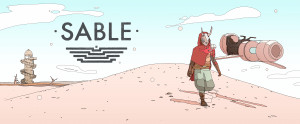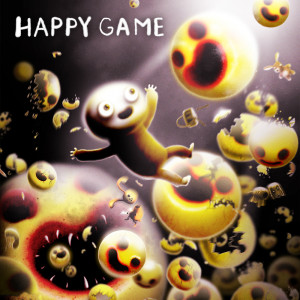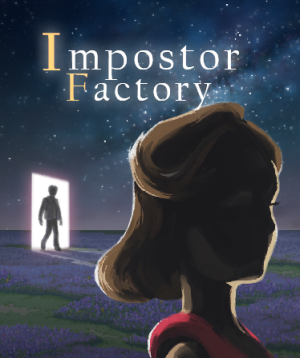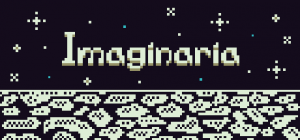Review for KAPIA

After spending just a short time with KAPIA, it was already evident to me that it was made by people who know and love the genre. The husband-and-wife duo at 2FOR2 have an obvious understanding of what makes adventure games great, and their premier production is a wholesome and engaging game filled with interesting characters, superb art, varied gameplay mechanics, well-designed puzzles and thoroughly developed lore. And yet some inexperience shows, as it feels somewhat underdeveloped. It doesn’t provide much of a challenge, contains a number of inconsequential scenarios, and the gameplay and narrative don’t feel as expansive or as intertwined as perhaps they could have been. Nevertheless, it’s obvious that a lot of effort and heart have gone into bringing this "funky” sci-fi world to life, and there is plenty to enjoy in its short but charming campaign.
The world of KAPIA has been torn apart by a catastrophic war, dividing the remaining population into coalitions of the East and West. The titular western domed setting now provides refuge for people and (intelligent) machines alike, the shelter providing protection while also preserving the beauty of the old city. Though the fighting has slowed, braving the nuclear winter outside is still fraught with risk, and few dare to venture beyond the city walls into this apocalyptic nightmare to seek the remnants of the world before the conflict.
Traces of the broader setting are everywhere, with details revealed in news broadcasts on screens in the town square, on posters for various underground groups covering the walls and alleyways, and through various conversations. The citizens also have personalized access to the Kapia computer network, where you can read articles about the history of the war, should you so choose. It’s an impressive amount of worldbuilding, leaving enough to wonder about while filling in enough of the backstory as seen through the eyes of a native Kapian. The narrative touches on hot topics including propaganda, artificial intelligence, and religious zealotry, but despite its grim setup, KAPIA is actually quite a happy game, and ultimately comes closer to Franklin is Lost than A Canticle for Leibowitz, rarely delving too deeply into its darkest themes.
You play (primarily) as two characters: Stefan, a veteran of the war, and his granddaughter Reny, whom he raised after Reny lost both her parents in the conflict. She is something of a girl genius, and despite her small stature and childhood innocence, her boisterous attitude and adventurous spirit soon get her tangled in a political power struggle occurring in the city. Stefan, on the other hand, is a bit gruffer, worn down by the decades of fighting for survival and the loss of his daughter and son-in-law, though he is still determined to make Kapia a better place for everyone.
The story begins with Stefan returning from the outside with a recording that may hold important answers about the origin of the war. Though his mission was secret, various competing sects have caught wind of Stefan’s trip, and he soon finds himself taken captive by a mysterious woman belonging to a revolutionary group. When Stefan doesn’t return home, Reny decides to search for him. As Stefan’s captor guides him (at gunpoint) towards the group’s lair, Reny looks for clues as to her grandfather’s whereabouts, following their trek through more roundabout means. The two criss-cross the streets and underbelly of the city, missing one and other by mere minutes on several occasions. Though Reny and Stefan play almost identically as protagonists, the predetermined swapping between them is a fun way to keep you invested in the plot, unraveling the story from two different angles.
Though some secondary characters are more or less disposable, simply serving as roadblocks or puzzles, others feel like they are part of the larger happenings, like Pam, a friend of Stefan’s who briefly assists him in navigating Kapia’s revolutionary underworld, or Mr. Bunny, Reny’s plush robot bunny who helps organize her chore list but later decides to go it alone and become an adventurer. You’ll even get to play as some of them from time to time, but it's a shame we see so little of them. The inclusion of these scenes is welcome but usually trivial, and they don’t explore any of the supporting cast’s narrative or gameplay potential.
One such sequence pairs Mr. Bunny riding atop a mechanical dog, and is a perfect example of a wasted opportunity given the duo’s unique partnership. The two of them are limited to retreading ground you previously explored with Stefan to retrieve an item of importance from a giant sentient robot head before the scene abruptly ends. This same robot has a deep and heartfelt (though melodramatic) conversation with Stefan near the start, touching on their losses in the war and how the robot's memories have been affected from the emotional distress it suffered. Unfortunately, this plot point isn’t pursued any further, like so many other narrative threads in the game. Several other key characters emerge seemingly out of nowhere, with little buildup as to their place in the story. The main antagonist, for example, is introduced so late in the game that the inevitable showdown lacks enough impact. Even the ultimate conclusion is tackled so hastily, it’s hard to feel its intended magnitude.
The voice-overs represent a diverse cast of actors, and though serviceable, the wild change in mixing levels and acting quality is a distraction. Actors from all across the world were used, and while there isn’t anything wrong with this approach per se, the lack of consistency is certainly noticeable. Some characters, like Reny, sound great. Stefan sounds a bit like a gruffer version of Christian Bale’s Batman, but the deep and rugged voice still suits him well. However, many of the supporting characters are considerably less convincing or sound as though perhaps their lines were recorded using less-than-professional sound equipment. The game is subtitled, and you can turn the voice volume down if you like, though there are a few typos in the script as well. Fortunately, KAPIA’s music lifts the whole audio production up, pumping a variety of upbeat string and flute arrangements to keep the mood light while also pushing you to move forward and uncover more of the mystery.
Though the 3D graphics may not be cutting edge, they have a definite charm to them. KAPIA looks like it would be right at home on the original Xbox, and I mean that as a compliment. Characters, despite their slightly angular builds, are nicely animated. Hair, for example, is solid as opposed to having dynamic individual strands, but the waxy cartoonish models look great, bouncing in rhythm with the characters’ speech. The robots look especially impressive with their animated screens for faces, complete with changing pixel art to show expressions and lip syncing. However, animations during conversations and cutscenes are somewhat stilted, with character movements looking stiff and repeating often.
Kapia itself is an interesting looking place. It is an old town, with streets and walls made from stone, wood, and plaster, while retro-tech like CRT television screens and monochrome computer monitors are fastened atop the aging architecture. Neon signs, steam-pressure valves, and the general mishmash of old and new make the whole environment look like a kid’s playset, not adhering solely to steampunk, cyberpunk, or any other singular style. Underground is a flooded network of arched stone tunnels, ventilation shafts, and even hi-tech fish hatcheries. There’s a lot of ambient animation throughout, and the city feels alive and inhabited, both on street level and below.
The camera will pan along with you as you move, but the changes between pre-set angles have trouble keeping up sometimes and don’t always do a good job of showing you what you need to see. The more serious problem with the camera occurred whenever I got lost in a blind spot, with the game refusing to pan enough to follow or switch to another angle to better track my movement. It’s not game-breaking, but it can be frustrating just trying to get your character maneuvered back into frame. I also found Stefan and Reny would sometimes get stuck on objects when I prompted them to interact with something and they were unable to make their way to the destination. Luckily you can cancel these commands, allowing you to readjust and get the character unstuck manually.
You’ll likely be carting around an item or two at any given time, with some points of interaction prompting the use of something in your possession. Once acquired, you are able to view items in your inventory manually by entering a first-person mode. Here you can examine them up close, and even activate functions on them, like flipping power switches or removing battery covers. The animation in first-person mode is superb, with elements like a character’s individual finger movements showing realistic detail.
KAPIA can theoretically be played with a keyboard and mouse or controller, but in practice the latter may be needed at some point. (More on that later.) I played most of the game this way anyway, as it allowed me to move freely via the thumbstick instead of having to click about the screen to reach each new destination. Either way, as you wander around, white circles connoting points of interest will hover overtop objects. Approaching and interacting with these hotspots will prompt Reny or Stefan to look at them and make a comment, or perhaps touch, collect, or use an item from their inventory there. With the mouse you can click the hotspots directly, or you can press TAB or a controller trigger to cycle through all interactive points within reach.
The game is divided into twelve discrete levels. Loading screens occur any time you move from one part of the city to another (usually signifying the end of that level), but most sections take place in a single small area, meaning you won’t have to backtrack long ways for items or triggers needed to progress. The game saves automatically throughout the level and at the beginning of a new one, meaning you’ll never lose too much progress if you need to quit.
Loading screens are accompanied by art submitted by the game’s Kickstarter backers (or rather, children of the backers), morphing into scenes and characters from the game as recorded in Reny’s colouring book. It’s a fun touch, and serves as a thoughtful bridge to connect supporters to the story without being superfluous. Reny’s colouring book, introduced in the first playable scene, contains a picture of her mother and father, and Stefan makes sure to bring Reny back crayons whenever he goes out on a trip, attaching further meaning to it.
Each of KAPIA’s central locations has a linear set of goals to be completed in order to move on. When Stefan first returns to the city, for example, he must find his way to another district whose access has been blocked by a large malfunctioning neon sign, while all alternate routes are impeded by a sociopathic talking cat in a mech suit. Other obstacles are more about pattern recognition, like when Reny must write and print out a computer punch card based on the correct sequence of criteria alluded to elsewhere. As with any traditional adventure, you can talk to or listen in on others to gain clues, or explore the environment for relevant items, documents, or details. Some dialogue trees are optional, only providing narrative background, while others trigger new goals to accomplish.
Most objectives are self-evident and don’t require much explanation, though several setups are a bit weird. One segment has Stefan working as a waiter at a bar in order to obtain money. He is still being held hostage at this point, with his captor sitting patiently at a table while he runs food out of the back while the barman is indifferent to Stefan’s situation. It’s easy enough to go along with what you’re supposed to be doing, but the context is a bit awkward and feels forced.
One or more hint dials may be present at any given time in the top right corner, and when time winds down on one you can click it to reveal a clue about what needs to be done, like telling you what character needs to be interacted with, or suggesting you return somewhere for further investigation. While some of the puzzles do require a bit of math or pattern recognition, none are overly hard, and the wait period (usually 1-3 minutes) isn’t too punitive if you’re really stuck – just long enough to motivate you to try to solve the puzzles on your own. If you want to avoid the temptation altogether, this feature can also be turned off at any point. Most of the time I found myself stalled, it’s because I hadn’t completed the required criteria in the correct order, like turning on Reny’s remote control helmet before attempting to use it on the household robot.
KAPIA also includes several mini-games, ranging from mopping the floor in the most efficient way possible by means of grid-like movement, to fishing for pickles in a barrel. Though often a nice diversion, the first of these you encounter is a sort of Rock ’Em Sock ’Em Robots boxing match against Reny’s friend Zimulis (another character never mentioned again after the initial meeting), and it isn't a great first impression, at least if you attempt it with the keyboard and mouse. Though on-screen button commands are provided for punching, I was unable to move my robot from his corner, and thus had to wait for Zimulis’s robot to approach and try to punch it away. I got beaten continuously, to the point where I thought there must be something outside of the mini-game that I needed to do in order to be able to beat him.
It turns out the only thing I was doing wrong was not using a controller. Neither keyboard nor mouse would make my robot move from his corner. However, the thumb stick on my gamepad, as expected, moved my robot left and right, and I proceeded to win the mini-game on my first try once I was able to bob and weave. Perhaps this will be fixed in an update, but I think the game plays better overall with a controller anyway.
Despite some rough technical edges like this, along with inconsistent voice acting and a few narrative shortcomings, KAPIA is a delightful game overall, with likeable protagonists in a fascinating world. It’s relatively easy, so it would be a great game to introduce a newcomer or younger gamer to the genre, though veteran adventure gamers will enjoy the well-designed puzzles and extensive worldbuilding as well. Whatever one’s experience, what matters most is that KAPIA is a fun game that just about anyone can enjoy, and I’m genuinely excited to see what 2FOR2 can do with a fuller, even better-rounded follow-up effort in the future.
































